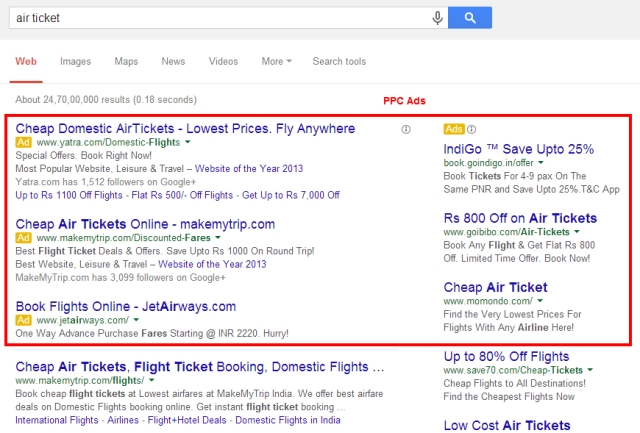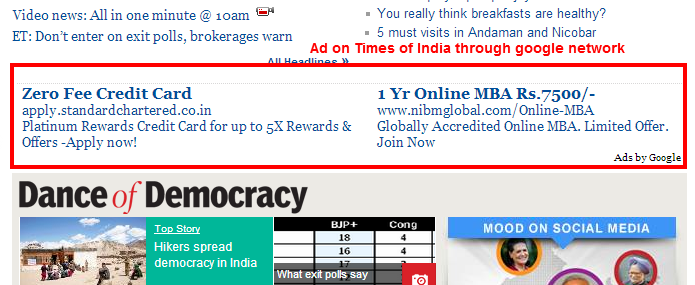Pay Per Click (PPC) advertising is an advertising system where the advertiser only pays when a potential customer clicks on your advertisement.
PPC advertisement on search engines are easy to spot – they’re the results listed as “sponsored links”. They can appear on the top of the results page, usually in a box, and also on the right hand side of the results page.
PPC advertising is keyword based – this means that it is based on the search term that a user enters into a search engine. A search term can have one word, or be made up of many words. Sometimes a multi-word search term is referred to as a “key phrase” or “keyword phrase”. As an advertiser you can target those keywords for which you want your advertisement to appear in search results.
For the advertiser, the beauty of PPC advertisement on search engines is that their adverts are displayed when potential customers are already expressing intent – they are searching for a product or service. It allows advertisers to present their offering to a potential customer who is already in the buying cycle.
Each of the three major search engines (Google, Yahoo!, Bing) has its own PPC advertising platform, namely AdWords, Yahoo! Search Marketing and adCenter. While the basic process remains the same for each one, there are some differences.
With PPC advertising, the advertiser:
- Creates the content for an advertisement.
- Selects the keywords for which that advertisement should appear.
- Chooses the maximum amount they are willing to pay for a click on the advert, and this amount can be unique to each keyword they have selected for an advert.
The search engine algorithm:
- Checks the advert for compliance to editorial guidelines.
- Displays the advert for relevant search queries.
- Determines the rank, or position, of the advert based on the advertiser’s maximum bid and the relevance of the advert (which includes factors such as CTR, and ad copy, keyword and landing page relevance to the search).
PPC advertisement on the content network
Advertisers can choose to have their adverts displayed on the search network only (which means on search engines), or they can select to have the adverts displayed on the content network.
The search network will include the search engine which owns the platform (so, Google for AdWords), as well as other search engines for which that platform provides paid results (for example, currently timesofindia.com uses the Adwords platform for paid results).
The content network refers to web sites other than search engines which also display PPC advertisement. For Google AdWords, these are the web sites and blogs which have joined Google AdSense, Google’s publishers’ platform. Google determines the content of the web site, and then displays appropriate PPC adverts. Typically, the CPC is lower than on the search network, but the CTR and conversion rate can be much lower.
Text PPC adverts follows the same basic structure:
The URL shown is not necessarily the URL that the user will click through to. When writing the copy, these are known as the display URL (what is shown on the advert) and the destination URL (what the actual URL of the page is). The display URL is sometimes also called a vanity URL. The aim should be to send users to a web page as specific to their search, and the PPC advert, as possible. This is known as deep-linking.
The display URL must be the same domain as the destination URL. Google will only show one advert per display URL.
So, an advert might look like this:
The search engines limit the characters in each line. There are also restrictions on what you are allowed to write in an advert.
Bidding and ranking of PPC advertisement
Advertisers need to determine the maximum they are willing to pay for a click on their advert, and they need to decide this for each keyword they enter for an advert. This bid is the maximum CPC, or Max CPC, that the advertiser is willing to pay for the click.
However, this will not necessarily be the CPC that the advertiser must pay for a click.
Every time a search query is entered, the search engine runs an auction to determine the placement of the adverts where advertisers have bid on that search term.
When it comes to ranking, of course, it’s not quite as simplistic as that (it rarely is!).
As well as the bid an advertiser places on a keyword, the search engine will take a number of other factors into account. In the case of Google AdWords, this is known as Quality Score.
The Quality Score is determined by, among other factors:
- The relevance of the keyword to the search term
- The relevance of the advert copy to the search term
- The relevance of the landing page to the search term
- The historic CTR of that advert
Search engines look at factors such as relevancy to try to ensure that it is not just having deep pockets that can land advertisers the top spot. Search engines need to ensure that users find the adverts relevant, otherwise they’ll be less likely to click on them – and no click means no revenue for the search engine.
Studies repeatedly show that those adverts nearer the top of the page (so the best ranked) attract the highest CTRs. They get the most clicks. And, the clicks cost the advertisers more.
Being in the top position means you will pay more per click. Many clicks at a higher price may use up your budget quickly. Also, many people click on the top advert believing it to be the top organic search result – often without reading the advert text.
Advertisers need to consider what a user does after clicking through to the advertiser’s web site from the search engine. When planning a PPC campaign, it is therefore crucial to set up the goals of the campaign, and make sure that these are being met. You can use your analytics package to set these up. With a goal set up, the advertiser can track how many of the users that click through to the web site follow through to that goal.
This is called a conversion.
Goals can be:
- Buying a product
- Filling in a form
- Downloading a E-book
- Sending an enquiry
- Booking a flight
We know that the CTR of an advert is clicks / impressions %. The conversion rate of an advert is conversions / clicks %.
As the advertiser, you also need to know the value of each conversion. You need to know this so that you don’t pay too much for your clicks, and so that you bid to have the best CTR for maximum ROI.

 +91 7420018003
+91 7420018003



